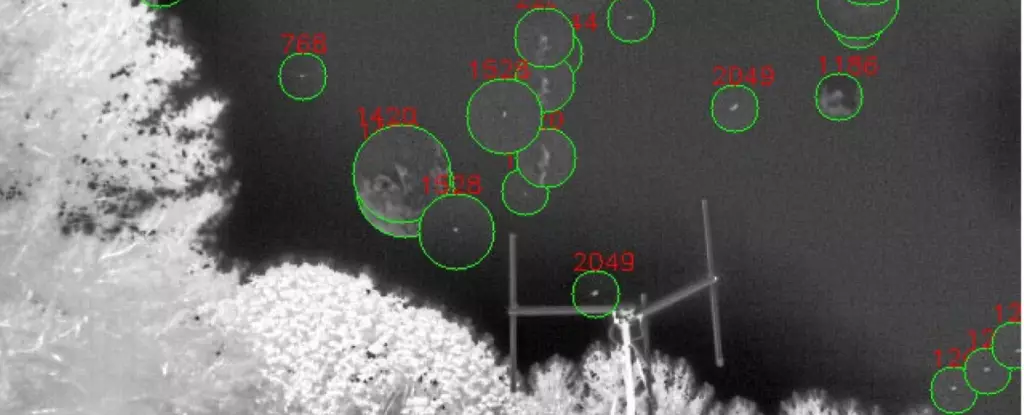In a groundbreaking turn of events, the release of declassified intelligence reports in 2021 has opened the floodgates to a serious discourse surrounding Unidentified Aerial Phenomena (UAP). The Office of the Director of National Intelligence (ODNI) threw light on these enigmatic objects, leading the Department of Defense to share annual reports through the All-domain Anomaly Resolution Office (AARO). However, despite the increase in public awareness and heightened governmental interest, the yearning for scientific clarity persists. Recent initiatives, particularly those spearheaded by the Harvard-Smithsonian Center for Astrophysics (CfA) and the Galileo Project, represent a new chapter in humanity’s quest to understand the cosmos.
The Call for Better Tools: Enter the Dalek
To address the apparent deficit in scientific data, researchers launched a bold proposal: the implementation of an All-Sky Infrared Camera, affectionately dubbed Dalek, intended to meticulously scan our skies for potentially non-terrestrial spacecraft. Led by Laura Domine, an ambitious researcher affiliated with the Galileo Project, the study attracted a collaborative effort from scientists across multiple institutions, demonstrating a significant shift in how we approach aerial phenomena. The Dalek project received an enthusiastic reception when details were presented at the 2025 Lunar and Planetary Science Conference, marking an important milestone in the search for extraterrestrial life.
The choice of the name Dalek, inspired by the iconic machine villains from the “Doctor Who” franchise, serves a dual purpose; it evokes a sense of urgency and intrigue while simultaneously hinting at the complexity of the endeavor. This proposal aims to enhance our observational capabilities in spectacular ways, designed to detect anomalies that could otherwise vanish in the vastness of the sky.
A Multimodal Approach: Understanding the Unexplainable
What sets the Dalek initiative apart from previous efforts is its commitment to a multimodal and multispectral observation framework. Recognizing that UAPs are not just visual phenomena but complex occurrences, the project incorporates a wide array of sensory data collection methods. By leveraging advancements clearly articulated in NASA’s 2023 independent study, researchers aim to design instruments that react instantaneously—within milliseconds—allowing rapid information sharing on transient events. The emphasis on multisensory data paves the way for more holistic understanding, enabling scientists to record not just motion and shape but also the spectral qualities and potential auditory signals of UAPs.
As Professor Avi Loeb, a prominent mind behind the Galileo Project, elucidates, conventional governmental data is often shackled by classification protocols that inhibit public and scientific scrutiny. However, the project’s all-sky observatories—spearheaded from Harvard and supplemented by facilities in Pennsylvania and Nevada—aim to democratize data collection. By utilizing infrared, optical, radio, and audio detection mechanisms, these observatories promise an abundance of insights into phenomena that remain elusive even to more clandestine studies carried out by the AARO.
Unraveling the Data Mystery: A Leap Forward in Detection
In a mere five months of operation, the Dalek and its observational peers managed to catalogue an astonishing half a million objects, flagging approximately 80,000 of them as outliers worthy of closer examination. This painstaking endeavor has resulted in the largest data set available concerning Near-Earth Objects (NEOs), aggregating crucial input for data processing via state-of-the-art machine learning algorithms. By employing a You Only Look Once (YOLO) model for object detection and a Simple Online and Realtime Tracking (SORT) algorithm to reconstruct trajectories, researchers are equipped to discern patterns and anomalies among millions of data points.
The ambition here transcends mere classification. As Loeb points out, the hope is to measure distances using triangulation from multiple observatory locations, yielding insights into the velocities and accelerations of detected objects. In this quest for classification, even the slightest indication of anomalous physics can lead to paradigm-shattering discoveries—such as the existence of advanced civilizations capable of creating technology far beyond our current understanding.
A Technological Renaissance: The Implications of Discovery
The implications of successfully identifying genuine technosignatures could reverberate through the collective human consciousness and scientific discourse. Loeb’s declaration that even one in a million anomalous findings can trigger a monumental shift in our perception hints at a philosophical revolution as much as a scientific one. The stars, once symbols of unreachable dreams, could very well harbor evidence of intelligent life that fundamentally alters our trajectory as a species.
As we stand on the brink of revolutionized understanding, the combination of technological innovation and collaborative scientific inquiry positions us strongly in the ongoing quest to decode the cosmos. The Dalek initiative is not merely a project; it is a symbol of hope, inspiration, and determination to elucidate the mysteries surrounding us. And who knows? The truth may be closer than we think.

